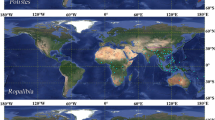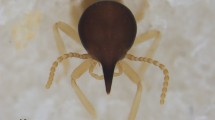Summary.
The rate of mitochondrial DNA evolution and the speciation pattern in relation to glacial periods are tested in the European taxa of the eusocial genus Reticulitermes. The linearized tree obtained from cytochrome oxidase II sequences and a geological event calibration shows a substitution rate 100-fold higher than that usually applied for insect mitochondrial DNA. An accelerated rate of evolution has also been observed in social Vespidae (Hymenoptera); we therefore suggest the involvement of eusociality in mediating gene pool drift. The role of the last ice age in speciation pattern of Reticulitermes taxa is supported by molecular data, but a four refugia model better explains genetic diversity, phyletic relationships and present-day distribution of these termites.
Similar content being viewed by others
Author information
Authors and Affiliations
Corresponding author
Additional information
Received 30 March 2004; revised 29 July and 15 November 2004; accepted 1 December 2004.
Rights and permissions
About this article
Cite this article
Luchetti, A., Marini, M. & Mantovani, B. Mitochondrial evolutionary rate and speciation in termites: data on European Reticulitermes taxa (Isoptera, Rhinotermitidae). Insectes Soc. 52, 218–221 (2005). https://doi.org/10.1007/s00040-005-0806-5
Issue Date:
DOI: https://doi.org/10.1007/s00040-005-0806-5




